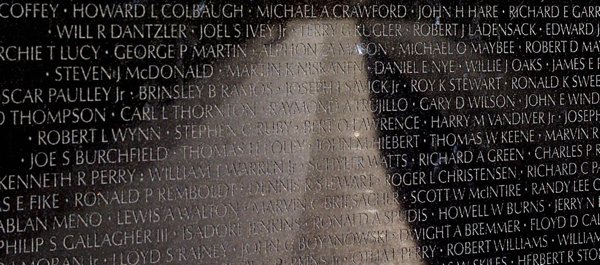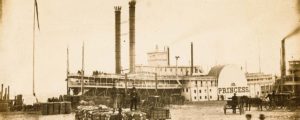
“The wall dematerializes as a form and allows the names to become the object”….Designer Maya Lin
The sheer tenacity of Jan Scruggs and fellow Vietnam veterans pushed an improbable idea from misty conception to real possibility, and ultimately to law, in just a year’s time. When President Carter signed legislation in July 1980 authorizing the Vietnam Veterans Memorial, not a soul knew what a monument to the fallen in a war that had so recently torn the nation apart would look like. The four criteria laid out to potential designers were both vague and precise. The first two, that the monument should “be reflective and contemplative in character, and harmonize with its surroundings” were clear enough. The third, “contain the names of those who had died in the conflict or who were still missing”—the point of Scruggs’ concept—would pose an interesting challenge. The final dictum, “make no political statement about the war,” seemed inconceivable.
Into this void entered a vision from a most unlikely source. Among some 1,400 entrants, a young architecture student’s simple yet ingenious design had an instant impact on the jurors. Acclaim for Maya Lin’s design was far from unanimous, of course. As Lin wrote about those times in 2000 in an eloquent—and rare—exposition in the New York Review of Books, “It was extremely naive of me to think that I could produce a neutral statement that would not become politically controversial simply because it chose not to take sides.”
Today, it is hard to comprehend the controversy and angst that engulfed the design of the memorial—whose healing effect on Vietnam veterans and the nation as a whole has truly been immeasurable.
The Building of the Vietnam Veterans Memorial Timeline
1979 Vietnam vet Jan Scruggs conceives the idea of a memorial to those killed in the Vietnam War that would serve several purposes: that their names would not be forgotten, that society would recognize that their sacrifices were honorable, and to help heal the wounds of veterans and the nation. He announces the founding of the nonprofit Vietnam Veterans Memorial Fund on Memorial Day. While few take note and fundraising is slow, a committed group of veterans build an organization and set Veterans Day 1982, as their goal for dedicating the memorial.
In November, after vowing to raise the funds for building the memorial, Scruggs enlists the support of Sen. Charles Mathias (Md.), who had been an opponent of the war, and Sen. John Warner (Va.). They announce plans to introduce legislation that would grant two acres of land near the Lincoln Memorial for the Vietnam Veterans Memorial.
1980 President Jimmy Carter signs legislation in July that had unanimously passed in Congress providing the site for the memorial. A design competition launches after architect Paul Spreiregen is hired as an adviser, design criteria are established and an eight-member design jury selected. By the end of the year, 2,573 registrations had been received.
1981 After five days of winnowing 1,421 design entries, the jury selected entry number 1026, noting it’s “a design which will stimulate thought rather than contain it.” The design belongs to 21-year-old Yale architecture student Maya Ying Lin. A press conference is held on May 6 to unveil the design and introduce Maya Lin to the public. Controversy builds over the summer as prominent veterans protest the design’s “minimalist” approach and what they regard as an unsuitable tribute to Vietnam veterans.
“The wall creates a magical moment of the living and the dead touching, and it is still as potent as the first time you saw it”
1982 In February, the Memorial Fund and design opponents reach a compromise and agree to add an inscription to the memorial, along with a flag and statue, as yet designed. Maya Lin regards the changes as violations of the integrity of her work. A groundbreaking ceremony on March 11 marks the start of construction. Sculptor Frederick Hart is chosen to design the statue. As frenzied construction moves ahead, a model of Hart’s statue is unveiled. Controversy over the placement on the site continues, and Maya Lin resigns from the project. A decision is made October 12 to locate the statue and flagpole away from the memorial, giving the appearance of the soldiers walking from a grove of trees toward the memorial. It will be dedicated two years later. On November 13, after a march to the site by Vietnam War veterans and supporters, the Vietnam Veterans Memorial is dedicated, culminating a week of events honoring Vietnam veterans.
1983 Diane Carlson Evans, a nurse who served in Vietnam, proposes that a statue be added to the memorial site to honor the nearly 10,000 women who served in Vietnam during the war. Eight nurses were killed and their names appear on The Wall. The Vietnam Women’s Memorial Project is formed.
1984 Frederick Hart’s statue, “The Three Servicemen,” is unveiled November 8. During a Veterans Day ceremony at The Wall, President Ronald Reagan officially accepts the Vietnam Veterans Memorial on behalf of the people of the United States.
1986 Visitors to The Wall hit a record high, topping 5 million.
1992 To mark the 10th anniversary of the memorial, the first “Reading of the Names at The Wall” takes place over the course of 72 hours prior to Veterans Day. President George H.W. Bush and First Lady Barbara Bush make a surprise late-night visit to join in reading the names of the fallen.
1993 After a decade-long struggle, the Vietnam Women’s Memorial statue, designed by Glenna Goodacre, is unveiled on November 11 near The Wall and The Three Servicemen statue.
1999 The Vietnam Veterans Memorial Fund inaugurates its annual Memorial Day ceremony to recognize veterans who have died since the war ended as a direct consequence of their service in Vietnam.
2003 President George W. Bush signs legislation into law on November 18 that authorizes the Vietnam Veterans Memorial Center to be built near The Wall and the Lincoln Memorial. The Vietnam Veterans Memorial Fund begins a campaign to raise private funds for the construction of the center.
2004 A granite plaque is dedicated near The Three Servicemen statue on November 10, “In memory of the men and women who served in the Vietnam War and later died as a result of their service.”
2006 The site location for the Education Center at The Wall is approved by the National Capital Planning Commission.
2007 The Wall receives the American Institute of Architects’ Twenty-Five Year Award, which notes that “it creates a magical moment of the living and the dead touching, and it is still as potent as the first time you saw it.”
2012 The Vietnam Veterans Memorial Fund announces in February that the planned Education Center has expanded its scope to include an exhibit that will also honor veterans from the wars in Iraq and Afghanistan. In a Memorial Day address at The Wall, President Barack Obama makes a presidential proclamation commemorating the 50th anniversary of the Vietnam War. In July, the National Capital Planning Commission gives preliminary approval to the site and building plans for the underground Education Center.




